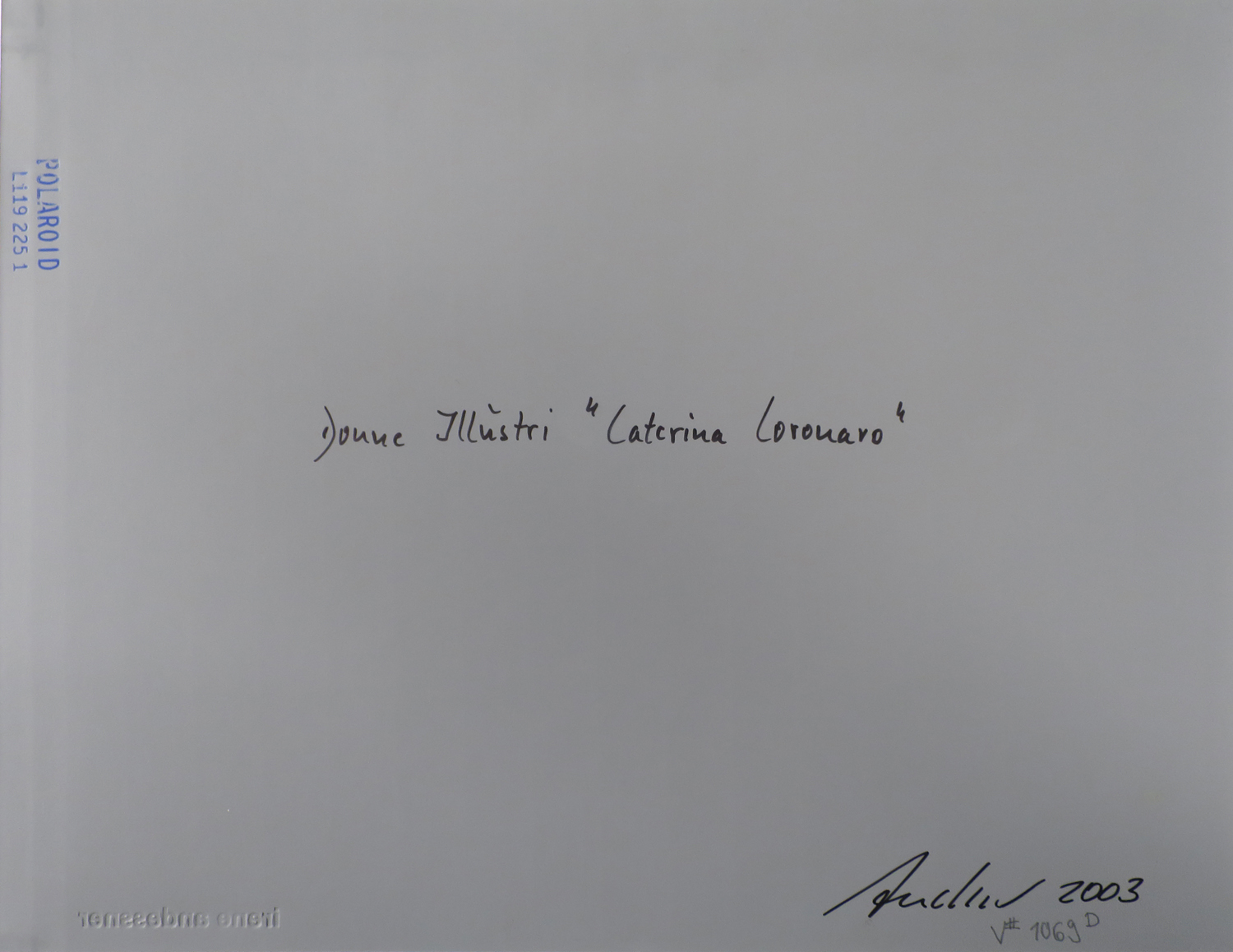"Catarina Cornaro"
instant photograph (Polaroid)
signed, titled, dated and numbered on verso
Catarina Cornaro (1454-1509)
Daughter of the Republic
Born on the 25th of November 1454, Saint Catherine’s Day, under the influential Corner family crest, Caterina Cornaro was destined to become the puppet sovereign of the island of Cyprus. Nominated by the Venetian Council of Ten as the “Daughter of the Republic” at the age of fourteen, she was sent to Cyprus and given as wife to Giacomo II, the illegitimate son and successor of Giovanni II of Lusignano. Upon the unexpected death of her husband and son, Giacomo III, born as successor to the Cyprian throne, Caterina Cornaro was crowned Queen of Cyprus under the Lusignano Flag, only to abdicate 15 years later, bowing beneath the pressure of her brother, Giorgio Cornaro, and retreating into state pension at Asolo. If, on the one hand, Caterina Cornaro obstructed the Republic from raising San Marco’s lion flag in Cyprus, on the other, she was the very person that made La Serenissima’s conquest of the island possible.
Donne Illustri
Caffà Florian on St Mark’s Square in Venice: in the “Sala degli Uomini Illustri” (salon of famous men) hang ten oil paintings by Giulio Carlini (1826–1887). Irene Andessner confronts these posthumously painted portraits of famous Venetians – from Marco Polo via Titian to Goldoni – with ten Venetian women, among them the city’s most famous composer (Barbara Strozzi) and painter (Rosalba Carriera) and the most expensive courtesan (Veronica Franco), as well as the first female doctor (Elena Lucrezia Cornaro Piscopia) and the world’s first female lawyer (Moderata Fonte). Through this intervention the Sala degli Uomini Illustri is transformed into the Sala delle Donne Illustri (salon of famous women). A picture puzzle-like disturbance: disregarding make-up, wardrobe, light, decoration and pictorial detail, Andessner’s portrayals differ from the historical picture references of the ten female figures in that she has not copied the bearing and look of the women, but rather of the men from the portraits hanging above. Thus the self-perception, the pre-potency of the male counterparts is broken.
A further room, the Saletta Liberty, is turned into the “Moderata Fonte Room” with a Fonte/Andessner photographic full-length self-portrait in a light box. Opposite this portrait Andessner places a “Fonte” portrait painted in oil on canvas, for which she sat as model in the workshop of Marinella Biscaro.
“7 Gentildonne”: as a preliminary to the exhibition Andessner convenes a meeting of seven Italians in the Caffà Florian men’s salon – inspired by Moderata Fonte’s debate in the novel “Verdienst der Frauen” [merit of women], documented as a video work. In the photo production for the Venice project there are additional full-length portraits, which transpose into our time the historicised portrayals of women (only visible in oval bust details in the room installation) by means of complete styling. In these images it can also be seen that the artist has the camera shutter release in her hand; which means – in contrast to earlier productions – she releases the image herself in just that moment when she herself inwardly feels the particular role so fully that she is sure she is bringing the personality of that model woman perfectly to expression. This way of working corresponds to the historical Venetian women, who likewise developed and lived out their professions self-determined and self-employed, independent of men. The full-length self-portraits are executed as light boxes.
The “Donne Illustri” project, curated by Stefano Stipitivich, takes place under the auspices of the Art Programme of the Caffà Florian. Started over 15 years ago by the caf» owner and art collector Daniela Gaddo Vedaldi, the series of exhibitions has so far represented artists such as Mimmo Rotella (1990), Fabrizio Plessi (1993 and 2001) and Luca Buvoli (1997)































